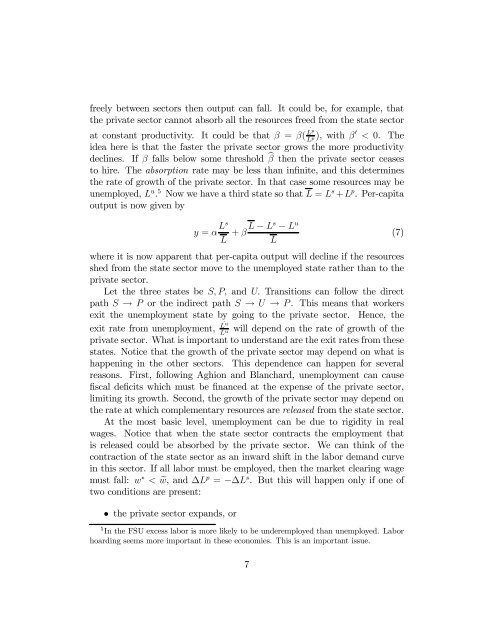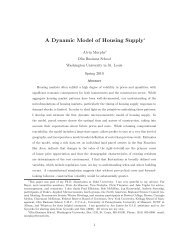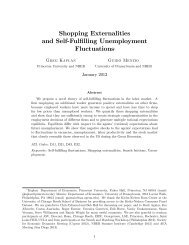Note on Adjustment and the Specific Factor Model
Note on Adjustment and the Specific Factor Model
Note on Adjustment and the Specific Factor Model
Create successful ePaper yourself
Turn your PDF publications into a flip-book with our unique Google optimized e-Paper software.
freely between sectors <strong>the</strong>n output can fall. It could be, for example, that<strong>the</strong> private sector cannot absorb all <strong>the</strong> resources freed from <strong>the</strong> state sectorLat c<strong>on</strong>stant productivity. It could be that β = β( · p),withβ 0 < 0. TheL pidea here is that <strong>the</strong> faster <strong>the</strong> private sector grows <strong>the</strong> more productivitydeclines. If β falls below some threshold β b <strong>the</strong>n <strong>the</strong> private sector ceasesto hire. The absorpti<strong>on</strong> rate may be less than inÞnite, <strong>and</strong> this determines<strong>the</strong> rate of growth of <strong>the</strong> private sector. In that case some resources may beunemployed, L u . 5 Now we have a third state so that L = L s +L p .Per-capitaoutput is now given byy = α LsL + β L − Ls − L u(7)Lwhere it is now apparent that per-capita output will decline if <strong>the</strong> resourcesshed from <strong>the</strong> state sector move to <strong>the</strong> unemployed state ra<strong>the</strong>r than to <strong>the</strong>private sector.Let <strong>the</strong> three states be S, P, <strong>and</strong> U. Transiti<strong>on</strong>s can follow <strong>the</strong> directpath S → P or <strong>the</strong> indirect path S → U → P . This means that workersexit <strong>the</strong> unemployment state by going to <strong>the</strong> private sector. Hence, <strong>the</strong>.Lexit rate from unemployment,uwill depend <strong>on</strong> <strong>the</strong> rate of growth of <strong>the</strong>L uprivate sector. What is important to underst<strong>and</strong> are <strong>the</strong> exit rates from <strong>the</strong>sestates. Notice that <strong>the</strong> growth of <strong>the</strong> private sector may depend <strong>on</strong> what ishappening in <strong>the</strong> o<strong>the</strong>r sectors. This dependence can happen for severalreas<strong>on</strong>s. First, following Aghi<strong>on</strong> <strong>and</strong> Blanchard, unemployment can causeÞscal deÞcits which must be Þnanced at <strong>the</strong> expense of <strong>the</strong> private sector,limiting its growth. Sec<strong>on</strong>d, <strong>the</strong> growth of <strong>the</strong> private sector may depend <strong>on</strong><strong>the</strong> rate at which complementary resources are released from <strong>the</strong> state sector.At <strong>the</strong> most basic level, unemployment can be due to rigidity in realwages. Notice that when <strong>the</strong> state sector c<strong>on</strong>tracts <strong>the</strong> employment thatis released could be absorbed by <strong>the</strong> private sector. We can think of <strong>the</strong>c<strong>on</strong>tracti<strong>on</strong> of <strong>the</strong> state sector as an inward shift in <strong>the</strong> labor dem<strong>and</strong> curvein this sector. If all labor must be employed, <strong>the</strong>n <strong>the</strong> market clearing wagemust fall: w ∗ < ew, <strong>and</strong>∆L p = −∆L s . But this will happen <strong>on</strong>ly if <strong>on</strong>e oftwo c<strong>on</strong>diti<strong>on</strong>s are present:• <strong>the</strong> private sector exp<strong>and</strong>s, or5 In <strong>the</strong> FSU excess labor is more likely to be underemployed than unemployed. Laborhoarding seems more important in <strong>the</strong>se ec<strong>on</strong>omies. This is an important issue.7
















